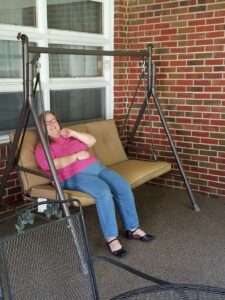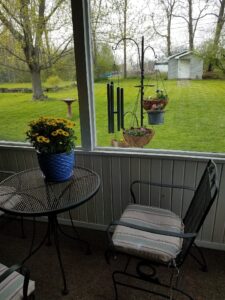Planning Garden Layout
The first thing that goes into planning my layout is to think about the space I have and where I want to b when I am enjoying my plants. Every space where I have lived already has plants in it, and most often I don’t go on a tour and find out what these are. I began to realize this was important at my last house, when I learned that there were roses growing outside my bedroom windows. I didn’t know how to care for them, and I was sorry. Caring for them properly would have meant that Kevin and I woke up to a wonderfully fragrance every morning.
I am now living in a place where I intend to be for quite a while, so I consider the plants that are already here and the size of the place in long-term planning. I have a large property and there are lots of ways I could expand what I do depending on how much time I want to spend.

For now I am designing a space that will increase my enjoyment of my sunroom and surrounding areas by giving me more fragrance. It also allows me to increase my exercise by getting out and tending.

This picture was taken in 2018. The flower on the table served as a centerpiece and left space for me and Kevin to have cups of coffee or bring our Ipads or small laptops out to do a little reading or writing. Today I have two pots on the table so not exactly a centerpiece.
The east side of the sunroom has an exit door, and outside the door is a sidewalk that borders the kitchen. Here there is room for some planters.
Another thing that influences garden planning is the level of shade and sun that plants will receive. Indiana’s spring and summer climate can vary wildly from one day to the next. It might be 90F or 95F one day and 70F the next. It is often fairly windy, and we can get a good bit of rain at times.
In my yard, plants to the east of the sunrom receive a great amount of sun. Those to the north receive some shade, especially if they are close to the west end of the sunroom.
There are existing plants in the ground on the east and north sides of the sunroom, but there is also some open space between plants on the north side and an empty space at the west end of the sunroom. There is a house wall that juts out at the west end of the sunroom and blocks the late afternoon sun and some wind. Plants in the corner near the house wall receive a high amount of shade.
My past experience is that most of what I have planted at ground level suffers because I have not been able to get down to reach it to care for it well. This year, I have planted two raised beds, several hanging baskets, and have placed several pots on a picnic table in order to elevate them so that I can access everything easily.
- Learning From My Younger Self - February 10, 2024
- more reflections on ITD - June 30, 2023
- On travel while at ITD: reflections after day 1 - June 27, 2023
- ITD day 1 - June 27, 2023
- ITD day 1 - June 27, 2023
- Job Descriptions, Inclusivity, and Equity for People with Disabilities - October 15, 2022
- Traveling without a Guide Dog: Experience with Cane and Walker - October 14, 2022
- Disability and Church, Intersection - June 11, 2022
- Review: When Chronic Pain and Illness Take Everything Away - June 11, 2022
- Grammar and Style Resources for Writers - June 9, 2022